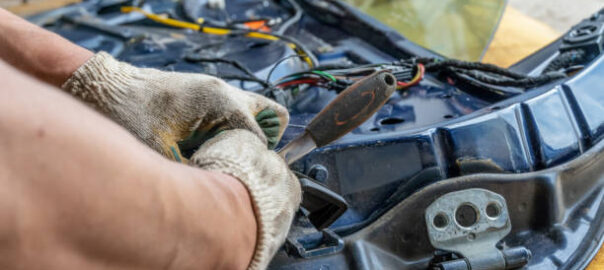Electronics play a pivotal role in various aspects of modern vehicles, ranging from the structural elements to the powertrain and even the entertainment systems. But when these vehicles reach the end of their useful life they are abandoned or stockpiled at poorly managed scrap yards.
These stockpiled vehicles often have recyclable components and parts (including electronics) that often hold value. If in good condition, they can be salvaged, reconditioned and sold to automotive repair shops or to individuals performing auto restoration projects.
However, salvaged electronics might pose security risks, such as short circuits, electrical fires, or other electrical failures when repurposed. Therefore, it’s crucial to thoroughly inspect and test salvaged electronics to ensure they meet safety standards in their new applications.
In this article, we will discuss the potential safety risks car wreckers can face during the process of repurposing.
Navigating the dangers: potential risks in repurposing car electronics
While repurposing old or salvaged car electronics can be an exciting venture for many car enthusiasts, it introduces a host of safety risks that demand careful consideration.
Here are some key concerns that individuals should be wary of when repurposing electronics:
Short circuits or fires
Salvaged vehicles have often experienced significant damage in accidents. Car electronics, including control modules and wiring, may have suffered structural damage that compromises their integrity. This damage could result in short circuits, electrical fires, or other electrical failures. Repurposing electronics without addressing these potential issues may lead to electrical malfunctions in their new applications.
Battery failure
Repurposing a car battery for other applications might lead to electrical safety issues. Car batteries are designed to handle specific loads and conditions; using them inappropriately could result in overheating, leakage, or even explosions. Also, it is advisable to remove batteries first before dismantling a wrecked car to make vehicles safe for handling other materials.
Compatibility concerns
Salvaged electronics may have hidden defects or damage that are not immediately apparent. They may also not be compatible with other vehicle systems or aftermarket components. Because different vehicle models and makes may have unique electronic architectures and communication protocols. Repurposing components from one vehicle for use in another may result in compatibility issues that could lead to unpredictable behavior and the overall safety and performance of the new vehicle.
Software and firmware issues
Automotive electronics often rely on specific software and firmware to function correctly. Repurposing these components may require reprogramming or modification of software, which can be complex and may introduce security vulnerabilities or operational issues if not done correctly.
To mitigate these risks, conduct thorough inspections of components for physical damage, ensure compatibility with the target vehicle and its systems, and adhere to legal and safety regulatory requirements.
Things to consider when dismantling car batteries
Batteries are often labeled as hazardous waste due to their toxic contents, reactive nature, and flammable properties. You can avoid this waste by recycling these batteries because recycled batteries offer good value for money.
However, caution and adherence to safety measures are crucial when dismantling waste batteries from wrecked cars. Utilize appropriate tools and personal protective equipment, especially when removing a battery pack from electric or hybrid vehicles. For severely damaged batteries, additional protective gear like a face shield is advisable. It’s important to note that a drive battery retains its electrical charge even after removal so caution is advised at all times.
.
To ensure safety and proper disposal, consider the following measures:
Store waste batteries in a moisture-free environment to prevent corrosion and potential leaks.
Stack them no higher than two units and use cardboard or plywood between stacks to avoid short circuits that may lead to electrical fires.
Wrap them in a leak-proof polyethylene liner and secure them to a pallet using nylon straps. This prevents movement during transportation and reduces the risk of damage.
Exercise caution to prevent cracking the battery casing during handling, as many recyclers may refuse buying leaking batteries.
Things to consider when dismantling car audio system
Dismantling and repurposing a car audio system involves working with electrical components, and it’s crucial to prioritize safety to avoid accidents and damage. Before starting any dismantling or modification, disconnect the car battery first to prevent electrical shocks and accidents.
Wear appropriate personal protective equipment, including safety glasses and gloves, to protect yourself from sharp edges, electrical contact, or exposure to potentially harmful materials. Be cautious when handling wiring to avoid electrical shocks.
Use appropriate tools and avoid applying excessive force when dismantling components. Applying too much force can lead to breakage, or damage to the components. Moreover, some older car audio systems may contain hazardous materials such as lead or other toxic substances. Be aware of the materials present and handle them with care.
Things to consider when dismantling hardwired GPS tracker
If the wrecked car has a hardwired GPS tracker, be cautious when dismantling as it also involves working with electronic components. Ensure that the GPS tracker is disconnected from the vehicle’s battery.
Before dismantling, visually inspect the GPS tracker for any signs of cracks or exposed wires. Do not proceed if the device appears damaged or compromised. Wear safety glasses and gloves, to protect against electrical contact and exposure to potentially harmful materials. Disconnect wires carefully, and use insulated tools to prevent accidental contact with live wires.
If you are unfamiliar with the specific GPS tracker model, seek help from the manufacturer of the same make and model on its components, wiring, and potential hazards.
Stay safe when dealing with wires
When it comes to repurposing car electronics from wrecks, your safety and security is definitely not something you want to skimp on. Always begin by disconnecting power sources to eliminate the risk of electrical shocks and use proper protective equipment, and exercise caution during dismantling and repurposing activities. By adhering to these safety measures, you not only safeguard yourself but also contribute to a successful and responsible recycling process.

